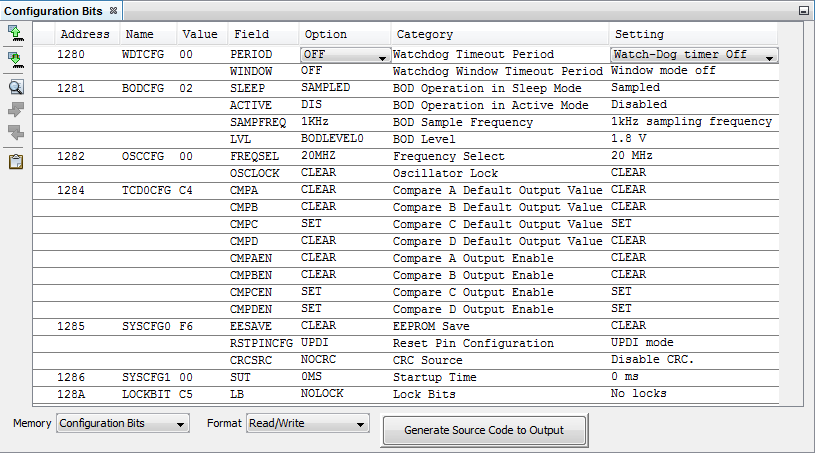Most configuration bits are contained in device Fuse bytes. To program the fuse bits, the
Fuse API is used. To use this API, include the <avr/io.h> header
file, which provides everything necessary to set the AVR fuses.
To program code protection configuration bits, or lock bits, the Lockbit API is used. To
use this API, include the <avr/io.h> header file.
An example using the FUSES and LOCKBITS
macros is provided below. For more information on the Fuse and Lockbit APIs, see:
https://www.microchip.com/webdoc/AVRLibcReferenceManual/group__avr__fuse.html
https://www.microchip.com/webdoc/AVRLibcReferenceManual/group__avr__lock.html
Example: ATtiny861 MCU
// ATtiny817 Configuration Bit Settings
// 'C' source line config statements
#include <avr/io.h>
FUSES = {
0x00, // WDTCFG{PERIOD=OFF, WINDOW=OFF}
0x02, // BODCFG{SLEEP=SAMPLED, ACTIVE=DIS, SAMPFREQ=1KHz, LVL=BODLEVEL0}
0x00, // OSCCFG{OSCLOCK=CLEAR}
0x00, // Reserved
0xC4, // TCD0CFG{CMPA=CLEAR, CMPB=CLEAR, CMPC=SET, CMPD=CLEAR, CMPAEN=CLEAR, CMPBEN=CLEAR, CMPCEN=SET, CMPDEN=SET}
0xF6, // SYSCFG0{EESAVE=CLEAR, RSTPINCFG=UPDI, CRCSRC=NOCRC}
0x00, // SYSCFG1{SUT=0MS}
0x00, // APPEND
0x00, // BOOTEND
};
LOCKBITS = {
0xC5, // LOCKBIT{LB=NOLOCK}
};The example above was generated from the Configuration Bits window (Window>Target Memory Views>Configuration Bits).
When you first open the Configuration Bits window, the data will be red, meaning you need
to read from device memory. Use the “Read Configuration Bits” icon  . Make any
changes to the data in the window and then write changes back to the device by using the
“Program Configuration Bits” icon
. Make any
changes to the data in the window and then write changes back to the device by using the
“Program Configuration Bits” icon  .
.
To preserve your settings in code, click either the “Generate Source Code to Output”
button, to put the code in the Output window for copy-and-paste into your code, or the
“Insert Source Code into Editor” icon  , to place
the code at the cursor in an editor window.
, to place
the code at the cursor in an editor window.
